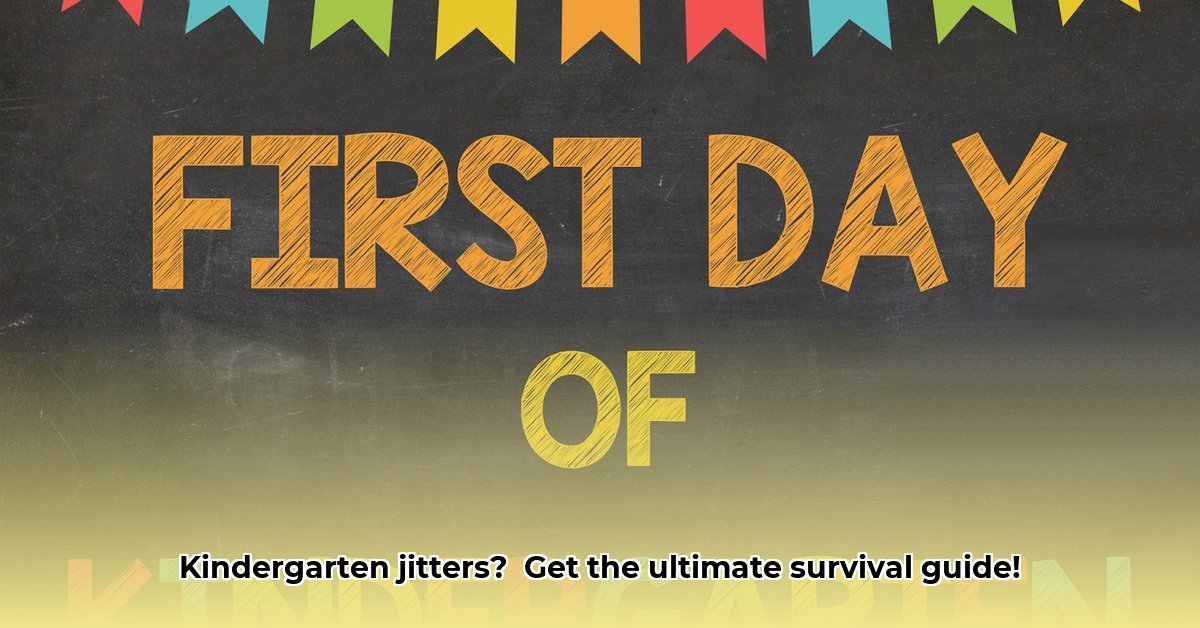The first day of kindergarten is a significant milestone, brimming with excitement and perhaps a touch of apprehension for children and their families. This comprehensive guide equips educators with the essential tools and strategies to ensure a seamless, positive transition. From cultivating a welcoming classroom atmosphere to effectively managing separation anxiety and fostering open communication with parents, we’ll explore actionable steps to set the stage for a successful and enriching school year.
Crafting a Welcoming and Stimulating Kindergarten Environment
The foundation of a successful first day lies in creating a classroom that exudes warmth, safety, and a sense of belonging. A thoughtfully designed environment can spark curiosity, encourage exploration, and foster a love of learning from the outset.
- Designing a Visually Appealing and Comforting Space: Transform your classroom into a vibrant and engaging learning haven by incorporating a carefully curated color palette. Consider using warm, inviting tones like sunny yellow and gentle orange to foster a sense of happiness and energy, or opt for calming blues and greens to promote a sense of tranquility and focus. Create designated areas within the classroom to cater to diverse learning styles and interests. A cozy reading nook adorned with plush cushions and an array of captivating books can invite quiet reflection and a love of literature. A hands-on learning center stocked with building blocks, puzzles, and manipulatives can encourage creativity, problem-solving, and collaborative play. Decorate the walls with student artwork, colorful posters, and educational displays to showcase their achievements and reinforce key concepts.
- Establishing Clear and Predictable Routines: Children thrive in structured environments where expectations are clear and consistent. Implement visual schedules and routine charts that illustrate the daily flow of activities, such as lining up for recess, transitioning between learning centers, and preparing for dismissal. These visual aids provide a sense of predictability and empower students to navigate the classroom with confidence and independence. Regularly review the routines with the students, using positive reinforcement and encouragement to promote adherence and understanding.
- Proactive Communication with Parents: Building strong partnerships with parents is crucial for a child’s successful transition to kindergarten. Initiate communication before the first day by sending welcome letters, newsletters, or emails introducing yourself, outlining your classroom goals and expectations, and providing practical tips for preparing their child for the school year. Host a pre-orientation event or open house to allow parents and children to visit the classroom, meet the teacher, and familiarize themselves with the school environment. Encourage ongoing communication throughout the year through regular newsletters, parent-teacher conferences, and digital communication platforms.
- Personalized Welcome: Consider a welcome letter or small, personalized desk decoration for each student to make them feel immediately welcome and valued.
Engaging Activities to Spark Curiosity and Foster Connection
The first day of kindergarten presents a unique opportunity to cultivate excitement for learning, foster positive relationships among students, and establish a vibrant classroom community.
- Icebreaker Games and Activities: Facilitate interactive icebreaker games that encourage students to learn each other’s names, share their interests, and build a sense of camaraderie. “Name Train” involves students stating their name and an adjective that begins with the same letter (e.g., “Amazing Amy”). “Two Truths and a Lie” challenges students to share three “facts” about themselves, with the others guessing which statement is false. These activities promote active listening, communication skills, and a sense of belonging.
- Interactive Read-Aloud Sessions: Select engaging read-aloud books that celebrate diversity, friendship, and the joy of learning. Incorporate interactive elements into the reading experience by asking open-ended questions, encouraging predictions, and inviting students to share their thoughts and feelings. ‘The Kissing Hand’ by Audrey Penn or ‘Chrysanthemum’ by Kevin Henkes are excellent choices.
- Classroom Exploration and Orientation: Lead students on a guided tour of the classroom, highlighting key areas such as the library corner, art center, writing station, and building blocks area. Explain the purpose of each area and demonstrate how to access and utilize the materials. Encourage students to explore the different areas at their own pace, fostering curiosity and a sense of ownership.
- Collaborative Art Project: Engage students in a collaborative art project that promotes teamwork, creativity, and a sense of accomplishment. Provide a large canvas or mural paper and invite students to contribute their individual artwork, creating a collective masterpiece that reflects the unique talents and perspectives of the class.
- (Optional) Gentle Introduction to Basic Skills: Introduce fundamental skills such as letter recognition, counting, and shape identification in a playful and engaging manner. Utilize hands-on activities, songs, and games to make learning fun and accessible. Avoid overwhelming students with excessive information or formal instruction on the first day. Focus instead on fostering a positive attitude toward learning and building a foundation for future success.
Empathetic Strategies for Easing Separation Anxiety
Saying goodbye to parents can be an emotional experience for some kindergarteners. Implementing compassionate and proactive strategies can help ease separation anxiety and create a sense of security and reassurance.
- Establish a Consistent and Predictable Departure Routine: Work with parents to create a consistent and predictable goodbye ritual. A quick hug, a cheerful “Have a great day!”, and a confident wave are often more effective than prolonged goodbyes. Encourage parents to establish a designated drop-off spot and avoid lingering in the classroom, as this can inadvertently prolong the anxiety.
- Create a Comforting and Nurturing Classroom Environment: Designate a quiet corner in the classroom as a “calm-down area,” equipped with soft toys, books, and calming music. This provides a safe and soothing space for students who are feeling overwhelmed or anxious. Offer individual attention and reassurance to students who are struggling with separation anxiety, validating their feelings and providing gentle encouragement.
- Maintain Open Communication with Parents: Keep parents informed of their child’s progress and well-being throughout the day by sending brief updates via text message, email, or a digital communication platform. Share positive anecdotes about their child’s participation in activities, interactions with classmates, and overall adjustment to the school environment. This open communication fosters trust and reassures parents that their child is safe, happy, and thriving in the classroom.
- Transitional Objects: Allow children to bring a small, comforting item from home, like a stuffed animal or a photo, to help them feel more secure.
- Visual Reminders: Display photos of the students’ families in the classroom to reinforce the connection between home and school.
Reflecting, Refining, and Planning for Ongoing Success
The first day of kindergarten provides valuable insights into the strengths and areas for improvement in your classroom practices. Taking time to reflect on the day’s events, gather feedback from parents, and adjust your plans accordingly will contribute to a more effective and enriching learning environment for all students.
- Conduct a Thorough Evaluation of the Day: Reflect on the day’s activities, transitions, and interactions. Identify what worked well, what could be improved, and what adjustments need to be made to better meet the needs of your students. Consider factors such as student engagement, participation levels, behavior patterns, and overall classroom dynamics.
- Solicit Feedback from Parents: Reach out to parents and solicit their feedback on their child’s first-day experience. Ask about their child’s emotions, anxieties, and overall perception of the school environment. Encourage parents to share any concerns or suggestions they may have for improving the transition process.
- Refine and Revise Your Plans: Utilize the insights gained from your evaluation and parent feedback to refine and revise your classroom plans, routines, and strategies. Make adjustments to activities, transitions, and communication methods to better address the needs of your students and create a more positive and effective learning environment.
- Document Observations: Keep a running record of student interactions, behaviors, and learning styles to inform future lesson planning and individualized support.
By prioritizing a warm and welcoming classroom environment, implementing engaging and interactive activities, addressing separation anxiety with empathy and compassion, and continuously reflecting and refining your practices, you can create a transformative kindergarten experience that sets the stage for lifelong learning and success. And as https://mydayinkinder.com/first-day-of-kindergarten/ advocates, fostering strong teacher-student relationships and providing parents with regular updates will solidify a supportive home-school connection.
Key Pointers:
- Establishing clear routines and expectations creates a safe and predictable learning environment.
- Designing a visually appealing and stimulating classroom fosters engagement and a sense of belonging.
- Proactive communication with parents builds trust and facilitates a strong home-school partnership.
- Addressing separation anxiety with empathy and compassion promotes a sense of security and reassurance.
- Continuous reflection and refinement of practices contribute to a more effective and enriching learning experience.
- Gluten Free Meal Prep Ideas for Delicious, Hassle-Free Eating - November 28, 2025
- Gluten Free Meal Prep for Stress-Free and Healthy Eating - November 27, 2025
- Quick And Easy Chicken Thigh Meal Prep For Weight Loss - November 26, 2025










